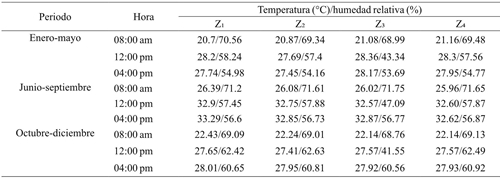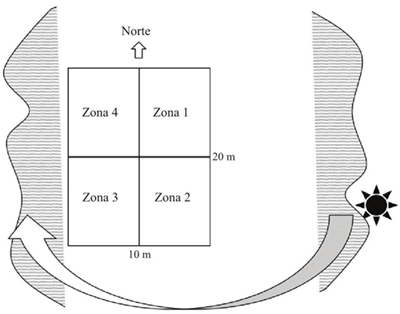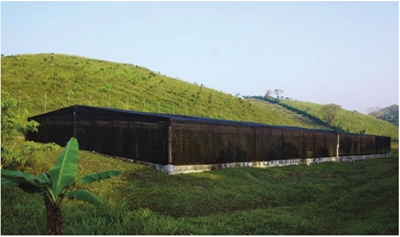Servicios Personalizados
Revista
Articulo
Indicadores
-
 Citado por SciELO
Citado por SciELO -
 Accesos
Accesos
Links relacionados
-
 Similares en
SciELO
Similares en
SciELO
Compartir
Revista mexicana de ciencias agrícolas
versión impresa ISSN 2007-0934
Rev. Mex. Cienc. Agríc vol.8 no.3 Texcoco abr./may. 2017
https://doi.org/10.29312/remexca.v8i3.44
Investigation notes
Relationship between temperature and relative humidity with the outbreak of the fungus Fusarium oxysporum f. sp. vanillae
1Laboratorio de Investigaciones Ambientales-UAEM. Av. Universidad 1001. Chamilpa, Cuernavaca, Morelos, México. CP. 62209. Tel. (777) 3520936. (ramosfernando747@gmail.com).
2Departamento de Ciencias Computacionales-ITESM. Autopista del Sol, km 104. Colonia Real del Puente, Xochitepec, Morelos, México. CP. 62790. Tel. (228)1009639. (a01091034@itesm.mx).
3Secretaría Académica-UAEM. Av. Universidad 1001. Chamilpa, Cuernavaca, Morelos, México. CP. 62209. Tel. (777) 5239003. (hector.sotelo@uaem.mx).
The objective of this paper is to determine the behavior of temperature (T) and relative humidity (RH) in different areas of a vanilla shade house and its relation with the outbreak of Fusarium oxysporum f. sp. vanillae (FOV). The shadow house is located in Gutiérrez Zamora, Veracruz. The behavior of T and RH from 2010 to 2014 was analyzed. Based on the monthly precipitation level, periods of the year that could favor FOV outbreaks were defined. The analysis was based on a set of rules constructed with information reported in the literature, which determine the ranges of T and RH that favor FOV outbreaks. The results showed that there are relevant relationships between the behavior of T and RH, the different areas of the shadow house and the FOV outbreaks during certain periods of the year. Two of four zones coincided with ranges of T and RH that favored FOV outbreaks. It is concluded that due to the orientation of the shadow house with respect to the path of the sun and the fact of being installed between two hills, the behavior of T and RH in certain areas of the shadow house favored the outbreak of FOV. In order to improve control of FOV outbreaks, it is proposed to use T and RH behavior monitoring systems in different areas of the shadow house.
Keywords: Fusarium oxysporum; diseases; greenhouse; monitoring; shadow house; rot; vanilla
El objetivo del presente estudio es determinar el comportamiento de la temperatura (T) y humedad relativa (HR) en diferentes zonas de una casa sombra de vainilla y su relación con el brote del Fusarium oxysporum f. sp. vanillae (FOV). La casa sombra se ubica en Gutiérrez Zamora, Veracruz. Se analizó el comportamiento de T y HR del año 2010 a 2014. Basados en el nivel mensual de precipitaciones, se definieron periodos del año que pudieran favorecer los brotes del FOV. El análisis se apoyó en un conjunto de reglas construidas con información reportada en la literatura, las cuales determinan rangos de T y HR que favorecen los brotes del FOV. Los resultados mostraron que existen relaciones relevantes entre el comportamiento de la T y la HR, las diferentes zonas de la casa sombra y los brotes del FOV durante ciertos periodos del año. Dos de cuatro zonas, coincidieron con rangos de T y HR que favorecieron en mayor medida los brotes del FOV. Se concluye que debido a la orientación de la casa sombra con respecto a la trayectoria del sol y al hecho de estar instalada entre dos cerros, el comportamiento de T y HR en ciertas zonas de la casa sombra favorece el brote del FOV. Para mejorar el control de brotes del FOV, se propone usar sistemas de monitoreo del comportamiento de la T y HR en diferentes zonas de la casa sombra.
Palabras clave: Fusarium oxysporum; casa sombra; enfermedades; invernadero; monitoreo; pudrición; vainilla
Vanilla is the only fruit orchid grown commercially to obtain vanillin (Ramírez et al., 2015; Koyyappurath et al., 2015). Vanilla needs certain conditions to have a good development, such as a temperature between 23 and 26 °C (Childers, 1948), and even between 20 and 30 °C (Hernández, 2011), annual precipitations between 2 000 mm and 3 000 mm, a high relative humidity around 70% and shade between 50 and 70% depending on the time of year (Hernández, 2011).
The production has been affected by the appearance of the FOV fungus, causing great losses to the producers (Pinaria et al., 2015; Adame et al., 2016). The fungus is found around the world and infects the host through the root (Koyyappurath et al., 2015; Pinaria et al., 2015).
It is known that the fungus benefits from environments with relative humidity levels of 74% to 80% and temperatures ranging from 23 to 28 °C (Gangadhara et al., 2010; Benaouali et al., 2014) which are within the propitious range for the best growth of vanilla (Hernández, 2011). These two opposing factors make prevention and control of fungus appearance a difficult and expensive task, especially in intensive farming systems such as shade houses and greenhouse, because the high density of the number of plants favors the infection (Suseela and Dhanesh, 2008).
In addition, current methods of bio-control and use of fungicides have not shown good results (Gangadara et al., 2010; Koyyappurath et al., 2015; Adame et al., 2015; Jiménez et al., 2015).
This paper aims to contribute to improve understanding of the FOV outbreaks causes of, whose complexity is associated with its multifactorial origin. In this multifactorial context, a relevant problem to be solved is modeling the multiple interactions that take place, becoming even more difficult as the number of elements involved in the interactions grows. For this reasearch, such interactions take place between the geographic location of the shadow house, its environment and its relation to climatic and environmental conditions.
The main objective of this research is to prove: first, that the temperature behavior and relative humidity are different depending on the location of selected areas within the shadow house; second, that the relationship between T and RH behaviors with climatic conditions, the orientation of the shadow house with respect to the trajectory of the sun, the important rainfall periods, the environment of the house and the conditions within it , make that in some areas of the shadow house the conditions for FOV outbreaks are favored.
The scope of the research is based on the analysis of T and RH data taken over 4 years, supported by rules that define T and RH ranges favoring FOV outbreaks. Such rules were developed based on information reported in the literature. The investigation is limited to a single shade house and to four preselected zones within it, within a particular environment (surrounded by two hills of considerable height) and with a particular orientation with respect to the sun’s path. The research will be enriched considering different conditions of other shade houses or greenhouses. In addition, an adequate number of areas to study, according to the size of the shadow house surface should be established.
This paper is the beginning of the future development of models combining environmental, climatic and genetic aspects that would give us clues to a better understanding of the FOV problem and thus helping decision making to improve performance in vanilla production in shadow houses and greenhouses.
A computer system that will help monitoring the behavior of the T and RH in real time through friendly interfaces is currently under development.
Important information about the shadow house: the shadow house is owned by the Gaya Company, located in Gutiérrez Zamora, Veracruz; geographic location: 20° 27’ 59.24” north latitude, 97° 6’ 52.56” west longitude, 8 km from Gulf of Mexico, climate: warm-humid with abundant summer rains (INEGI, 2009) Shade, 200 m2, surroundings: located between two hills, the west hill has a height of 63 m, the east hill of 53 m, both above sea level. The shadow house is 48 m. high above sea level. Therefore, the West Hill is approximately 15 meters higher than the shadow house (equivalent to a building of 4 to 5 floors) and the eastern hill, 5 meters high with respect to it; HT1 sensors provide temperature and humidity data; precipitation data from 2010 to 2014 were provided by INEGI.
The shadow house was divided into four zones (Figure 1), each with sensors providing T and RH data, whose main purpose was to find a relationship between the behavior of the T and the RH with data of the fungus outbreaks in these four areas during the years 2013 and 2014.
Based on similar rainfall patterns in the region from 2010 to 2014, the year was divided into 3 periods (Figure 2): January-May, June-September, and October-December. In addition, a more punctual analysis of rainfall behavior was carried out during 2013 and 2014, in three moments of the day: 8:00 am, 12:00 pm and 16:00 pm.
Table 1 shows the average T and RH for the three different periods in three different hours and within the four zones where the sensors were installed.
Table 1 Average temperature and relative humidity of the four zones for the three periods at three different hours throughout the year 2013.

For the purposes of this research, rules were made based on studies reported in the literature, that relate T and RH ranges favoring FOV outbreaks (Gangadara et al., 2010; Benaouali et al., 2014; Jiménez et al., 2015), which are described below: the ideal T that favors FOV outbreaks is 25 °C, the T range from 23 °C to 28 °C favors FOV outbreaks, T’s out of range 23 °C to 28 °C help to reduce FOV outbreaks, 20 °C range of values below 23 °C, help reduce FOV outbreaks; if T’s > 30 °C, the outbreaks are better than T’s <20 °C. In other words, FOV outbreaks are better resistant to low T’s than to very high T’s; RH> 75% favor outbreaks.
Discussion of results based on analysis of Tables 2 and 3. Table 2 shows in column 1 the facts and rules based on T and HR ranges favoring FOV outbreaks. The three periods considered in this paper are also shown. From column 2 to 5 of Table 2, the number of times each zone satisfies the rule described in column 1 was perceived.
Table 2 Confrontation of the rule on T and HR ranges favoring FOV outbreaks against the number of times an area satisfies the corresponding rules.

In Table 3, column 1 shows the facts and the rule based on T and RH ranges that do not favor FOV outbreaks.
The following observations derived from the analysis of the previous tables, they show which are the zones that satisfy to a greater extent the rule that they relate the ranges of T and RH that favor the outbreaks of FOV. In addition, the period where the conditions for favoring FOV outbreaks were given are the following: 1) zones with higher relative humidity, Z4 and Z3; 2) zones with lower temperatures, Z4 and Z3; 3) areas which have to a greater extent satisfied the conditions for FOV, Z4 and Z3 outbreaks; 4) Z4, zone with better conditions to favor outbreaks of FOV. Z1, area with less favorable conditions for outbreaks; 5) according to the values of T and RH, Z1 presented the lowest number of outbreaks; 6) HR’s <74% and T’s> 28 °C are favorable conditions for outbreaks control; 7) most sanitation actions (70%) occurred in zones Z4 and Z3, which are areas of higher relative humidity and lower temperatures; 8) the areas that retain the most favorable conditions for the development of FOV were those with more occurrences of FOV outbreaks. Those zones were the Z3 and the Z4; and 9) the June-September period largely met the conditions of the FOV outbreak.
Derived from the analysis of results, it is proposed in this paper that the following factors also contribute to the conditions of RH and T described in point 7: the hills surrounding the shadow house block the sunlight producing shadows on it throughout the day (Figure 3); water runoff from the hills; the effects of wind tunnels due to both hills.
Laboratory tests have shown that the development of FOV is more important at T= 25 °C. Growth of FOV is affected as T decreases or increases with respect to T= 25 °C (Gangadara et al., 2010). Fusarium oxysporum species also benefit from relative humidity valuesin the range of 74 to 80% and in environments with higher shade (Benaouali et al., 2014; Jiménez et al., 2015). The number of areas to be measured depends on the total area of the shade house. In this case each of the four zones covers an area of 50 m2. Further study is required to determine the ideal number of zones to be measured. As the number of zones grows, precision grows and the ability to avoid inaccurate and inaccurate data also grows.
Conclusions
In this paper it is concluded that T and RH behaviors are affected by climatic conditions, the orientation of the shadow house with respect to the sun tray, the important periods of rainfall and the environment of the shadow house, making that in some areas of the house the conditions for FOV outbreaks are favored.
It is recommended to develop a real-time monitoring system to monitor T and RH values in different areas of the greenhouse shadow house.
Literatura citada
Adame, J.; Luna, M. and Iglesias, L. G. 2016. Vanilla Rhizobacteria as antagonists against Fusarium oxysporum f. sp. vanillae. Int. J. Sc. Nature. 18(1):23-30. [ Links ]
Benaouali, H.; Hamini, N.; Bouras, A.; Benichou, S. L.; Kihal, M. and Henni, J. E. 2014. Isolation, pathogenicity test and physicochemical studies of Fusarium oxysporum f. sp. radicis lycopersici. Adv. Environ. Biol. 8(10):36-49. [ Links ]
Childers, N. F. 1948. Vanilla culture in Puerto Rico. Washington, D. C.: U. S. Dept. of Agriculture. 28. United States. 77-94 pp. [ Links ]
Gangadara, N. B.; Saifulla; Nagaraja, R. and Basavaraja, M. K. 2010. Biological control of Fusarium oxysporum f. sp. vanillae, the causal agent of stem rot of vanilla in vitro. Int. J. Sci. Nature. 2(1):259-261. [ Links ]
Hernández, J. 2011. Producción de planta de calidad de vainilla. INIFAP. México. Folleto Técnico Núm. 60. 32 p. [ Links ]
INEGI (Instituto Nacional de Estadística y Geografía). 2009. Gutiérrez Zamora, Veracruz de Ignacio de la Llave. Prontuario de información geográfica municipal de los Estados Unidos Mexicanos. México. 9 p. [ Links ]
Jiménez, K.; Schmidt, A.; Quesada, M. y Moreira, I. 2015. Aislamiento de una bacteria endófita de vainilla (Vanilla planifolia) con actividad biocontroladora in vitro contra Fusarium oxysporum f. sp. vanillae. España. Tecnología en Marcha. 28(2):116-125. [ Links ]
Koyyappurath, S.; Conéjéro, G.; Bernard, J.; Lapeyre, F.; Jade, K.; Chiroleu, F. and Grisoni M. 2015. Differential responses of vanilla accessions to root rot and colonization by Fusarium oxysporum f. sp. radicis- vanillae. Frontiers in Plant Sci. 6:1125. [ Links ]
Pinaria, A. G.; Laurence, M. H.; Burgess, L. W. and Liew, E. C. Y. 2015. Phylogeny and origin of Fusarium oxysporum f. sp. vanillae in Indonesia. Plant Pathol. 64:1358-1365. [ Links ]
Ramírez, M. A.; Iglesias, L. G.; Luna, M. and Castro, A. A. 2015. In vitro phytotoxicity of culture filtrates of Fusarium oxysporum f. sp. vanillae in Vanilla planifolia Jacks. Sci. Hortic. 197:573-578. [ Links ]
Suseela, R. and Dhanesh, J. 2008. Ocurrence of fungal diseases in vanilla (Vanilla planifolia andrews) in Kerala. India. J. Spi. Aromatic Crops. 17(2):140-148. [ Links ]
Received: January 2017; Accepted: March 2017











 texto en
texto en 






